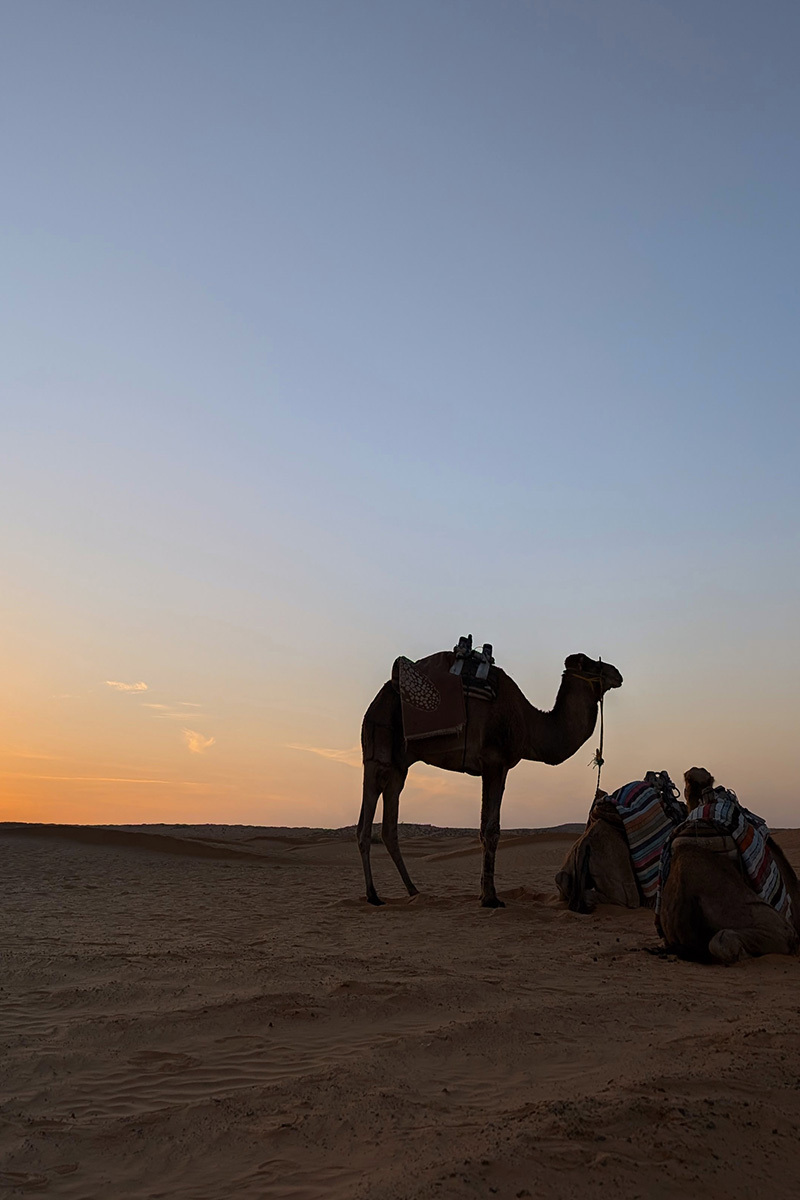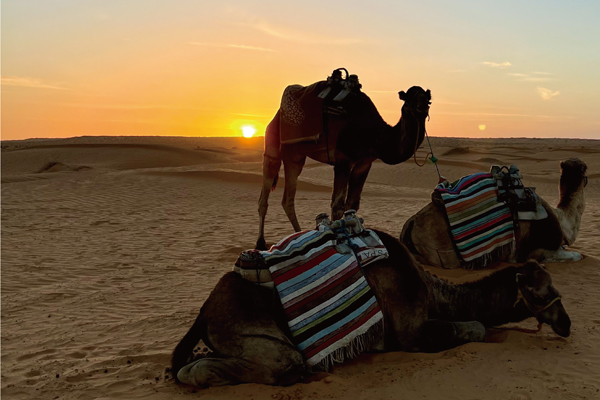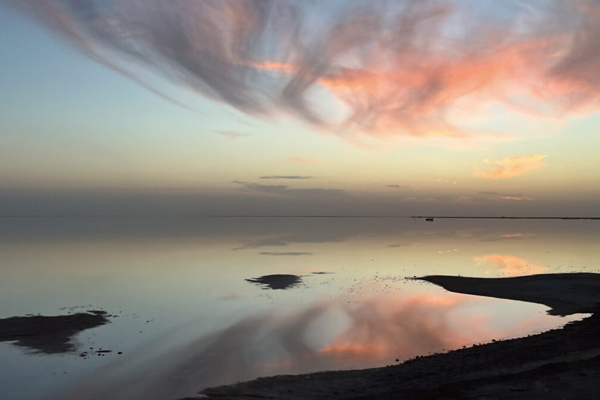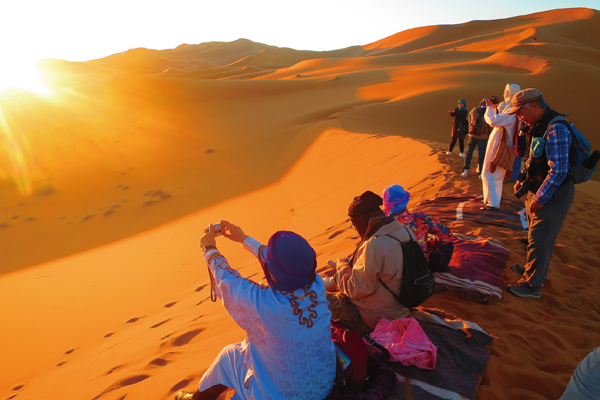カルタゴ〜ローマ〜アラブとつづくチュニジアで、歴史に浸る。
Feature | 2025.3.24

世界で6番目につくられた国、古代カルタゴが前身のチュニジア。
そこには深い歴史と文化が息づいている。
チュニジアの首都チュニスの近く、海に突き出た岬にフェニキア人たちの夢の跡、カルタゴ遺跡がある。フェニキア人は、エジプトなど東地中海からの様々なモノを西地中海の金や銀と交換し、それらをまた東地中海へ運ぶことで財を成した、古代地中海で活躍した商業民族。そんなフェニキア人の海上交易拠点となったのがカルタゴ。
フェニキア人たちはカルタゴに一大都市を築く。そこには紀元前7世紀から神殿や墓地があり、金属加工や陶器製造、染色などの工房が軒を連ね、街として発展していた。紀元前5世紀頃以降になると街路が碁盤の目に整備された、現代に繋がる都市計画に基づいた街づくりがされたという。そんな都市カルタゴも紀元前146年、ローマとの戦争に敗れ滅亡。そしてカルタゴ遺跡が残された。ここでは、当時のカルタゴの栄華を感じることができる。地中海を背景に、古代住居や共同浴場の跡を巡る。海風を受けながら、紀元前に想いを馳せる。
こうしてチュニジアはフェニキア人によるカルタゴの時代からローマ人に支配される時代になる。その頃を偲ぶ地が、チュニスから南西へ約100kmにあるドゥッガ。ここには紀元前46年にローマ支配下に入り、その後、ディオクレティアヌス帝の時代に繁栄した都市があった。いまドゥッガはアフリカ大陸最大のローマ古代都市遺跡となっている。
5000人とも1万人ともいわれる人々が暮らしていた街には、3階建ての大浴場や19段の客席があった劇場、神殿、さらには下水システムまで完備されていたといい、今でもその跡を目にすることができる。標高600mの丘の上というロケーションも相まって、スケールの大きな遺跡群がそこにいる人を圧倒する。神殿跡にそそり立つ数本の巨大な柱の前では、足が動かなくなった。こんなに迫力のある遺跡は、初めて見た。
カルタゴにもドゥッガにも、建物の壁面にモザイク画があった。当時の人物や風俗、動物、神話に登場する神などが描かれている。細かな石を敷き詰めて絵画のような表現をするモザイク画はフェニキア人の手によって描かれた。その後、ローマの時代にその技術は高められ、見事な作品が多く生まれたといわれている。そんなモザイク画がたっぷり鑑賞できるのが、チュニスにあるバルドー博物館。ここにはモザイク画の傑作とともに、イスラムのタイル模様、カルタゴ時代の石像などが集められている。
教科書のなかでは退屈だったものを、実際に目にして感動する。歴史の面白さをチュニジアが教えてくれた。
From Carthage to Rome to the Arab world,
a journey through layers of history.
Tunisia, home to ancient Carthage—one of the world’s oldest civilizations—is a land steeped in history and culture.
Near Tunisia’s capital, Tunis, on a promontory overlooking the sea, lie the ruins of Carthage—traces of the Phoenicians’ grand ambitions. The Phoenicians were seafaring traders who thrived in the ancient Mediterranean, amassing wealth by exchanging Eastern Mediterranean goods for Western gold and silver, then transporting their treasures back east. Carthage became one of their most vital maritime trade hubs.
The Phoenicians built a great city in Carthage. By the 7th century BCE, it had flourished into a bustling urban center with temples, cemeteries, and workshops for metalworking, pottery, and dyeing. By the 5th century BCE, the city adopted a grid layout—an early example of urban planning that still influences cities today. However, in 146 BCE, Carthage fell to Rome and was destroyed. Now, only ruins remain, yet the grandeur of ancient Carthage can still be felt. With the Mediterranean as a backdrop, visitors can explore remnants of ancient dwellings and communal baths. As the sea breeze brushes past, I let my thoughts drift back in time.
Tunisia transitioned from the Phoenician era of Carthage to Roman rule. One of the best-preserved sites from that time is Dougga, about 100 km southwest of Tunis.
Dougga came under Roman control in 46 BCE and later flourished during the reign of Emperor Diocletian. Today, it is the largest Roman archaeological site in Africa. Once home to an estimated 5,000 to 10,000 people, the city featured a three-story public bath, a theater with 19 rows of seating, temples, and even an advanced sewage system—traces of which remain today. Perched atop a 600-meter-high hill, the vast ruins command an overwhelming presence. Standing before the towering columns of a temple, I found myself frozen in awe—I had never seen ruins so powerful, so breathtaking.
Both Carthage and Dougga featured mosaic-adorned walls, depicting people, daily life, animals, and mythological gods. The Phoenicians introduced the art of mosaic—crafting intricate, painting-like images from tiny stones. Under Roman rule, the technique advanced, resulting in stunning masterpieces. For a full immersion in these mosaics, the Bardo Museum in Tunis is the place to visit. Alongside exquisite mosaics, it showcases Islamic tile patterns and Carthaginian stone statues.
What once felt dull in textbooks came to life before my eyes, leaving me deeply moved. Tunisia revealed the true excitement of history.


アフリカ最古のモスク、ケロアンの「グランドモスク」。 The Great Mosque of Kairouan, the oldest mosque in Africa.

閲覧中の特集はこちら





